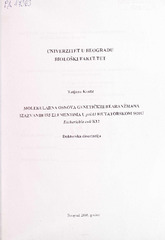Приказ основних података о дисертацији
Molekularna osnova genetičkih rearanžmana izazvanih IS5 elementima u polA1 mutatorskom soju Escherichia coli K12
Molecular basis of genetic rearrangements induced by IS5 elements in polA1 mutator strain of E.coli K12
| dc.contributor.advisor | Knežević-Vukčević, Jelena | |
| dc.contributor.other | Simić, Draga | |
| dc.contributor.other | Topisirović, Ljubiša | |
| dc.creator | Kostić, Tatjana | |
| dc.date.accessioned | 2020-01-27T12:20:36Z | |
| dc.date.available | 2020-01-27T12:20:36Z | |
| dc.date.available | 2020-07-03T08:15:01Z | |
| dc.date.issued | 2001 | |
| dc.identifier.uri | http://eteze.bg.ac.rs/application/showtheses?thesesId=7111 | |
| dc.identifier.uri | https://nardus.mpn.gov.rs/handle/123456789/11745 | |
| dc.identifier.uri | https://fedorabg.bg.ac.rs/fedora/get/o:20765/bdef:Content/download | |
| dc.identifier.uri | http://vbs.rs/scripts/cobiss?command=DISPLAY&base=70036&RID=21589519 | |
| dc.description.abstract | U našem prethodnom radu na polA1 mutantima pokazali smo da polA1 kreira mutacije isključivo tipa minus fs i delecija. U mutacionom spektru histidinskih auksotrofa bila je prisutna i jedna specifična kategorija delecija, velike delecije, koje su prolazile preko celog his operona. Veličina delecija je ukazivala da one nastaju u procesu rekombinacije izmedju homologih sekvenci, a poznato je da u polA mutantima dolazi do povećane frekvence rekombinacije. Ovaj rad predstavlja završni deo naše originalne studije polA1 indukovane mutageneze praćene na histidinskom operonu hromozoma E.coli. Analizirani su molekularni mehanizmi nastajanja velikih delecija, ili proces rekombinacije koji promoviše ove genomske rearanžmane. Pokazali smo da velike delecije nastaju kao rezultat rekombinacije izmedju dve IS5 sekvence koje se nalaze sa obe strane his operona. Sve četiri nezavisno izolovane delecije su bile jednake i iznosile su 35 kb. Analizom sekvence rekombinovanih IS5 elemenata pokazali smo da rekombinacija uvek prolazi kroz levi terminus IS5 i da se odigrava po tipu “site specific” rekombinacije. Levi terminus IS5 elementa ima karakteristično zakrivljenje DNK uslovljeno njenom primarnom strukturom i sadrži mesto za vezivanje IHF proteina. Rezultati ovog rada zajedno sa podacima iz literature ukazuju na moguću ulogu IHF proteina u nastajanju velikih delecija i u procesu rekombinacije. Primenom PCR tehnologije pokazli smo da je frekvenca nastajanja velikih delecija povećana kod polA1 i dam mutanata i da velike delecije nastaju na recA nezavisan način. PolA1 ne pokazuje nikakvu specifičnost jer se rekombinacija dešava na isti način i kod divljeg soja, ali je frekvenca rekombinacije dva puta povećana u polA1 mutantima u odnosu na divlji soj. | sr |
| dc.description.abstract | In our previous work on polA1 mutants we have shown that polA1 creates exclusively minus fs and deletions types. In mutational spectra of histidine auxotrophs, one specific category of deletions, large deletions, that cover all his operon, was present. The size of deletions pointed out that they appear in a process of recombination between homology sequences; it is known that polA1 mutants show an increased frequency of recombination. This work presents final part of our original study of polA1-induced mutagenesis followed on histidine operon of chromosome E.coli. Molecular mechanisms of appearances of large deletions, or process of recombination promoting this chromosomal rearrangement, was analysed. We showed that large deletions appear as a result of recombination between two IS5 sequences located on both sides of his operon. Four independently isolated deletions were identical, 35 kb long. Sequence analysis of recombinant IS5 elements was show that recombination always goes throught the left terminus of IS5, as a “site specific” recombination. Left terminus of IS5 contains a characteristic sequence-directed bent DNA, including a binding site for IHF protein. The data from literature, including the present results, point to a possible role of IHF protein in appearance of large deletions and process of recombination. Applying a PCR technology, we show that the frequency of large deletions is increased in polA1 and dam mutants, and that large deletions appear on recA independent way. PolA1 is not sequence specific because the process of recombination between two IS5 is identical in wild type and polA mutants, but the frequency of recombination is two times higher in regard to wild type. | en |
| dc.format | application/pdf | |
| dc.language | sr | |
| dc.publisher | Универзитет у Београду, Биолошки факултет | sr |
| dc.rights | openAccess | en |
| dc.rights.uri | https://creativecommons.org/licenses/by-nc-nd/4.0/ | |
| dc.source | Универзитет у Београду | sr |
| dc.subject | mutageneza | sr |
| dc.subject | mutagenesis | en |
| dc.subject | polA1 | sr |
| dc.subject | rekombinacija | sr |
| dc.subject | delecije | sr |
| dc.subject | IS5 | sr |
| dc.subject | PCR | sr |
| dc.subject | polA1- recombination | en |
| dc.subject | deletions | en |
| dc.subject | IS5 | en |
| dc.subject | PCR | en |
| dc.title | Molekularna osnova genetičkih rearanžmana izazvanih IS5 elementima u polA1 mutatorskom soju Escherichia coli K12 | sr |
| dc.title.alternative | Molecular basis of genetic rearrangements induced by IS5 elements in polA1 mutator strain of E.coli K12 | en |
| dc.type | doctoralThesis | en |
| dc.rights.license | BY-NC-ND | |
| dc.identifier.fulltext | https://nardus.mpn.gov.rs/bitstream/id/3504/Disertacija.pdf | |
| dc.identifier.fulltext | http://nardus.mpn.gov.rs/bitstream/id/3504/Disertacija.pdf | |
| dc.identifier.rcub | https://hdl.handle.net/21.15107/rcub_nardus_11745 |


